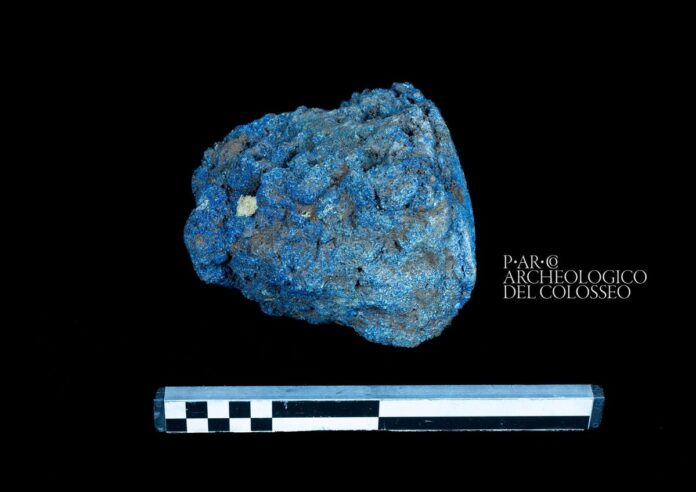:focal(1024x731:1025x732)/https://tf-cmsv2-smithsonianmag-media.s3.amazonaws.com/filer_public/f3/b9/f3b97d61-3bcc-4bf0-b8da-b0a932293e16/blue1.jpg)
The hunk weighs a whopping five pounds and measures more than six inches long.
Simona Murrone / Colosseum Archaeological Park
In the ruins of Rome’s opulent Domus Aurea palace, archaeologists have uncovered an array of ancient pigments used by artisans to paint the walls of the emperor Nero’s stately marble home with resplendent frescoes some 2,000 years ago.
Inside the remnants of workshops, the archaeologists recovered an amphora containing yellow ocher and small jars filled with reddish pigments like realgar and red ocher. They also came across basins where artisans would have mixed pigments with water.
But the highlight of the haul is a solid hunk of Egyptian blue, a rare pigment prized for thousands of years for its shimmering and ethereal qualities.
Yellow ocher discovered inside a Roman amphora Simona Murrone / Colosseum Archaeological Park/https://tf-cmsv2-smithsonianmag-media.s3.amazonaws.com/filer_public/40/2f/402f54a5-9707-4a45-960a-3edf1c7dfe80/yellow1.jpg)
“The fascination conveyed by the depth of blue of this pigment is incredible,” says Alfonsina Russo, the director of the Colosseum Archaeological Park, which manages the Domus Aurea, in a statement, per a translation by Gizmodo’s Margherita Bassi. “The Domus Aurea once again moves [us] and restores the brilliance of the colors used by the painters who skillfully decorated the rooms of this precious and refined imperial palace.”
Unlike ocher and realgar, which occur naturally, Egyptian blue is a synthetic pigment produced by firing a mixture of silica, limestone and minerals containing copper and sodium carbonate at high temperatures. It is considered the world’s oldest known synthetic pigment.
As its name suggests, the blue pigment originated in ancient Egypt. Dating to at least the third millennium B.C.E., it became an “essential element” in decoration and design, according to La Brújula Verde’s Guillermo Carvajal. It provided the subtle shading on ancient Egyptian portraits and the vivid coloring of faience funerary figurines.
The Roman architect Vitruvius recorded the recipe in his treatise De Architectura in the first century B.C.E., reflecting how the color spread through the Mediterranean world and found a thriving home in the Roman Empire, where researchers have since identified Egyptian blue in the Baths of Titus and the walls of Pompeii.
Egyptian blue is the world’s oldest known synthetic pigment. Simona Murrone / Colosseum Archaeological Park/https://tf-cmsv2-smithsonianmag-media.s3.amazonaws.com/filer_public/82/75/82754a58-476e-4591-9a93-4084ee0bba43/blue2.jpg)
Often, archaeologists discover traces of Egyptian blue that are all but imperceptible to the human eye. For instance, with the help of microscopes and luminescent imaging, researchers at the British Museum discovered that Egyptian blue once adorned the Parthenon marbles. In other cases, the pigment has been found in fine powders or small spheres, according to the statement.
But what makes this discovery at the Domus Aurea all the more remarkable is the whopping size of the Egyptian blue ingot in question, which weighs more than five pounds and measures six inches long.
Basins where the pigments were hydrated and mixed with water Simona Murrone / Colosseum Archaeological Park/https://tf-cmsv2-smithsonianmag-media.s3.amazonaws.com/filer_public/00/81/008165e1-8d48-46c3-9ba5-6e209daa881e/tanks2.jpg)
The great size of this sample suggests widespread usage in the palace’s frescoes, as well as the “specialized skills of the masters working on the imperial project,” as Artnet’s Min Chen writes.
Archaeologists are investigating whether this sample of Egyptian blue was produced domestically—in a place like Cuma, Liternum or Pozzuoli, which Vitruvius noted as a production hub—or exported from an Egyptian city like Alexandria, according to the statement.
Researchers once thought that the pigment’s recipe was lost after the fall of the Roman Empire, only to be rediscovered in the 19th century by the British chemist Humphry Davy. But in recent years, Egyptian blue has been found in Renaissance artworks, including Giovanni Battista Benvenuto’s 1524 painting St. Margaret and Raphael’s 1512 fresco The Triumph of Galatea.
Raphael’s 1512 fresco The Triumph of Galatea uses the Egyptian blue pigment./https://tf-cmsv2-smithsonianmag-media.s3.amazonaws.com/filer_public/6c/3e/6c3e16b4-ca81-4736-92d2-08705d02d19a/galatea_raphael.jpg)
Artists like Raphael and Domenico Ghirlandaio were known to sneak into the ruins of Nero’s home to admire and take artistic inspiration from the frescoes completed in the first century C.E., according to Artnet.
The presence of Egyptian blue in the Domus Aurea suggests a colorful past that inspired another generation of Italian painters to recreate the vivid blue in their own work. As the statement notes, the discovery provides another link between the art of antiquity and the art of the Renaissance.

